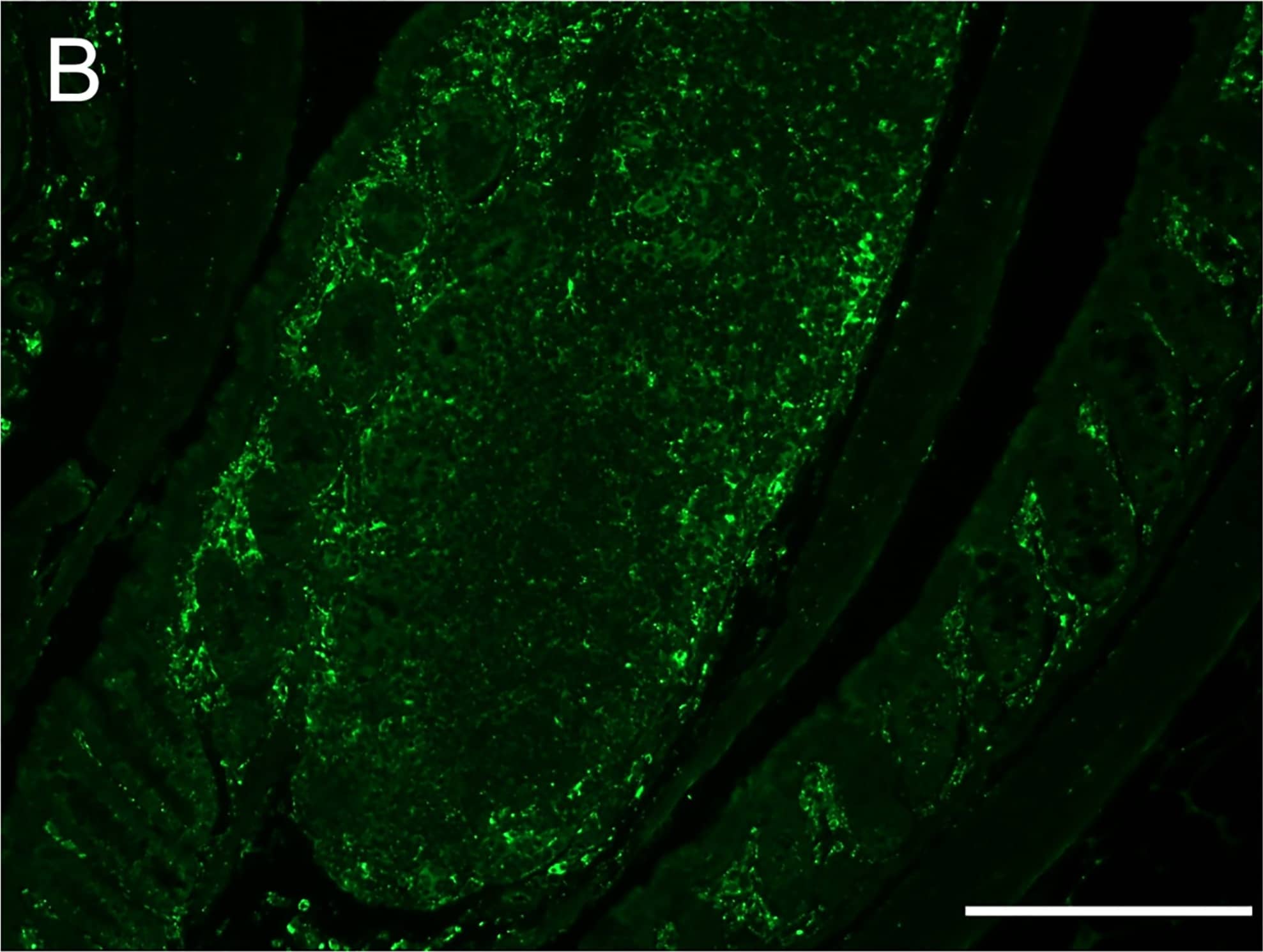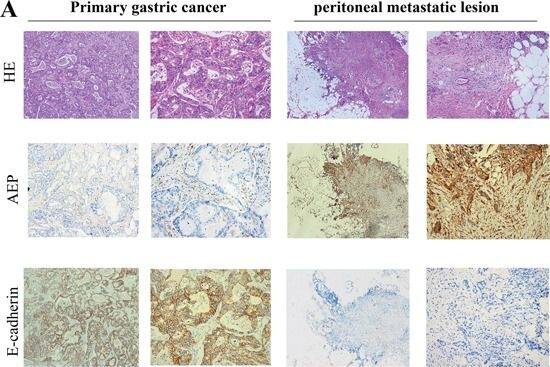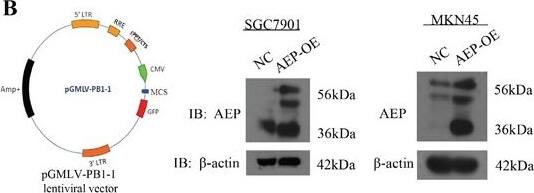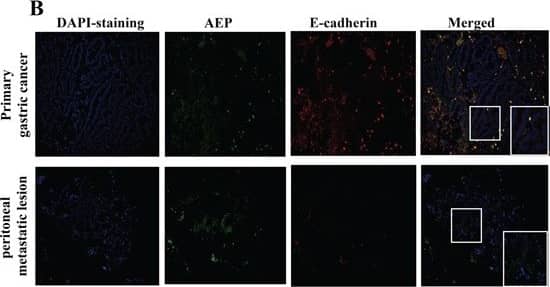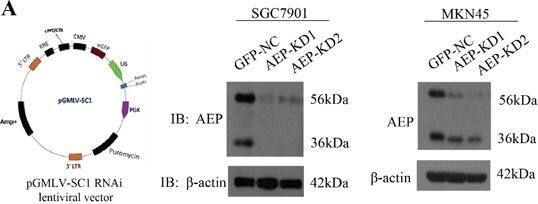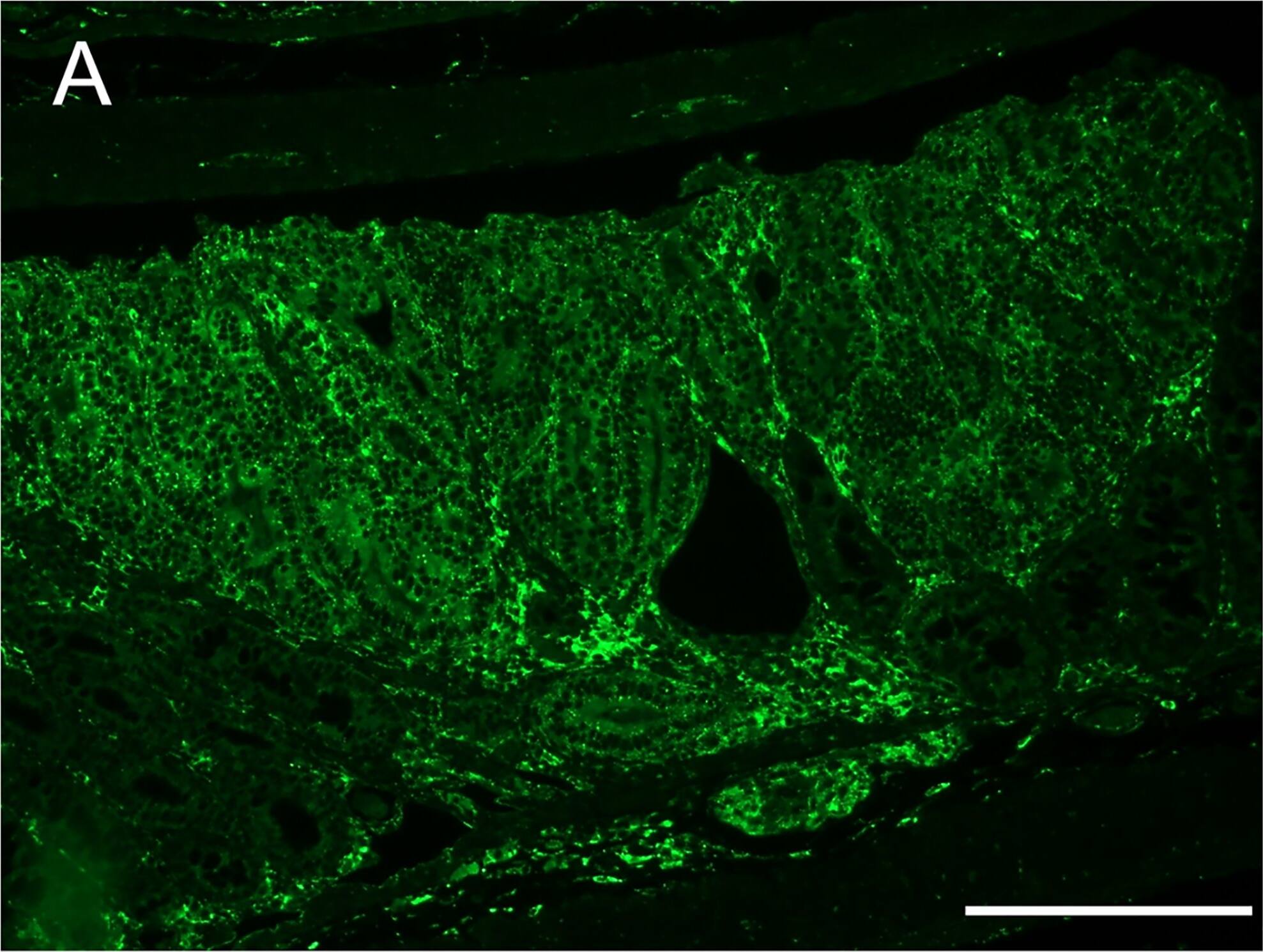Human Legumain/Asparaginyl Endopeptidase Antibody
R&D Systems, part of Bio-Techne | Catalog # AF2199


Key Product Details
Validated by
Species Reactivity
Validated:
Cited:
Applications
Validated:
Cited:
Label
Antibody Source
Product Specifications
Immunogen
Ile18-Tyr433
Accession # Q99538
Specificity
Clonality
Host
Isotype
Scientific Data Images for Human Legumain/Asparaginyl Endopeptidase Antibody
Detection of Human Legumain/ Asparaginyl Endopeptidase by Western Blot.
Western blot shows lysates of human kidney tissue, human heart tissue, and human placenta tissue. PVDF membrane was probed with 1 µg/mL of Goat Anti-Human Legumain/Asparaginyl Endopeptidase Antigen Affinity-purified Polyclonal Antibody (Catalog # AF2199) followed by HRP-conjugated Anti-Goat IgG Secondary Antibody (Catalog # HAF109). Specific bands were detected for Pro-Legumain/ Asparaginyl Endopeptidase at approximately 56 kDa and mature Legumain/Asparaginyl Endopeptidase 37 kDa (as indicated). This experiment was conducted under reducing conditions and using Immunoblot Buffer Group 1.Detection of Human Legumain/Asparaginyl Endopeptidase by Western Blot
The expression of AEP was higher in diffuse type gastric cancer than that in intestinal type gastric cancerA. AEP expression in intestinal type gastric cancer and diffuse type gastric cancer were detected by western blot (Representation: I, intestinal type gastric cancer; D, diffuse type gastric cancer, P=0.032). B. Patients' basic characteristics. Image collected and cropped by CiteAb from the following publication (https://www.oncotarget.com/lookup/doi/10.18632/oncotarget.8879), licensed under a CC-BY license. Not internally tested by R&D Systems.Detection of Mouse Legumain/Asparaginyl Endopeptidase by Immunocytochemistry/Immunofluorescence
Representative sections showing overall higher expression of legumain (diffuse yellowish fluorescence staining) in the untreated (A) versus the Andosan™-treated (B) intestine.Notably, legumain expression was higher in tumor tissue seen in untreated animals. Scale bars represent 200 μm. Image collected and cropped by CiteAb from the following publication (https://dx.plos.org/10.1371/journal.pone.0167754), licensed under a CC-BY license. Not internally tested by R&D Systems.Applications for Human Legumain/Asparaginyl Endopeptidase Antibody
Immunoprecipitation
Sample: Conditioned cell culture medium spiked with Recombinant Human Legumain (Catalog # 2199‑CY), see our available Western blot detection antibodies
Western Blot
Sample: Human kidney tissue, human heart tissue, and human placenta tissue
Reviewed Applications
Read 2 reviews rated 4.5 using AF2199 in the following applications:
Formulation, Preparation, and Storage
Purification
Reconstitution
Formulation
Shipping
Stability & Storage
- 12 months from date of receipt, -20 to -70 °C as supplied.
- 1 month, 2 to 8 °C under sterile conditions after reconstitution.
- 6 months, -20 to -70 °C under sterile conditions after reconstitution.
Background: Legumain/Asparaginyl Endopeptidase
Legumain is a lysosomal cysteine protease whose activity is found in several tissues tested (1, 2). Legumain plays a pivotal role in the endosomal/lysosomal degradation system because the Legumain deficiency causes the accumulation of pro cathepsins B, H and L, another group of lysosomal cysteine proteases (3). Over-expression of Legumain in tumors is significant for invasion/metastasis (4). Also known as Asparaginyl Endopeptidase, it specifically cleaves peptide bonds with Asn at the P1 position. Nevertheless, it also cleaves peptide bonds with Asp at the P1 position. Auto-activation of pro Legumain involves both types of the cleavage, which result in the removal of the pro peptides in both C- and N-termini (5). In addition, Legumain activates pro MMP-2 and processes bacterial antigens for MHC class II presentation and pro thymosin alpha to thymosin alpha1 and thymosin alpha11, two acidic peptides with immunoregulatory properties (6‑8). Human Legumain is synthesized as a 433 amino acid precursor with a signal peptide (residues 1‑17). The pro enzyme (residues 18‑433) was expressed with an N-terminal His tag. This activity of Legumain can be inhibited by recombinant human (rh) Cystatin C and rhCystatin E/M and recombinant mouse Cystatin C (R&D Systems, Catalog # 1196‑PI, 1286-PI and 1238-PI, respectively).
References
- Chen, J.-M. et al. (1997) J. Biol. Chem. 272:8090.
- Tanaka, T. et al. (1996) Cytogenet. Cell Genet. 74:120.
- Shirahama-Noda, K. et al. (2003) J. Biol. Chem. 278:33194.
- Liu, C. et al. (2003) Cancer Res. 63: 2957.
- Li D.N. et al. (2003) J. Biol. Chem. 278:38980.
- Chen, J.M. et al. (2001) Biol. Chem. 382:777.
- Schwarz, G. et al. (2002) Biol. Chem. 383:1813.
- Sarndeses, C.S. et al. (2003) J. Biol. Chem. 278:13286.
Alternate Names
Gene Symbol
UniProt
Additional Legumain/Asparaginyl Endopeptidase Products
Product Documents for Human Legumain/Asparaginyl Endopeptidase Antibody
Product Specific Notices for Human Legumain/Asparaginyl Endopeptidase Antibody
For research use only

